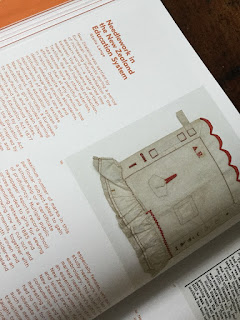The Art and Science project I was working on back in August was finished, and exhibited and is now a pattern uploaded to Ravelry.
The Exhibition catalogue is here, and contains images of the works in the exhibition. The image I used was a progress image, a developmental image. At the time the catalogue went into pre-print set up I just hadn't enough of the final project completed to use it in the catalogue. The pattern is here, and sets out the background to the project. I collaborated with Prof Craig Marshall, of the University of Otago. Craigs interest was in the way biological matter changes the structure and formation of ice. I went with the term Dirty Ice - but its more complex than that, its about scale and structure and repetition - and I tried to capture those ideas in a modified lace.
The final pattern is for a double layer lace cowl, the lace shifts from a larger triangular structure that repeats over six stitches into a medium lace structure that repeats over four stitches, to an even tighter version that repeats over four stitches. The goal was to transition - and I found a solution that used both fewer stitches (so a closer spacing) and also different sized holes. Some used double yarn overs to create four stitches, others used double yarn overs to create two stitches, and the lasts used a single yarn over to create two stitches. The transitions need to be fluid - I couldn't just switch between the two laces - I needed to find a way to merge them together over so they blended and morphed the way the structure of ice did. The lace also had to be triangular - as I learned ice was. It felt like breaking the rules - but also like I was beginning to understand this lace knitting just a little bit more. What was really exciting was the number of comments on the pattern - and that within the first few months several projects have appeared. In my other world, my work world, I write my research up into papers, and publish them. One of the ways we 'measure' the success of our publications, is in citations - how many times other people use 'our' work in their work. I'd like to think that having a pattern worked by another knitter is a little bit like being cited. And in a follow up I have signed up to take part in 2020 - meaning the opportunity for another collaborative project.
 This is probably my big news this week - something I wrote is in a book, a book on New Zealand Crafting. A few years back Damion Skinner held a series of workshops around New Zealand - inviting people to workshop and discus what craft was, what craft meant and what craft could be. We were asked to develop a definition of Craft that worked for makers, for owners, for curators and for theorists - it was hard. The workshops were funded by Creative New Zealand. Following the workshops people were asked to contribute to a book to be published.
This is probably my big news this week - something I wrote is in a book, a book on New Zealand Crafting. A few years back Damion Skinner held a series of workshops around New Zealand - inviting people to workshop and discus what craft was, what craft meant and what craft could be. We were asked to develop a definition of Craft that worked for makers, for owners, for curators and for theorists - it was hard. The workshops were funded by Creative New Zealand. Following the workshops people were asked to contribute to a book to be published.The article is short, but hopefully clear to people who want to read about craft and craft education. One of the areas I research is how people were taught about mending. I was curious why people were not teaching mending any more - and I know it is tied up in the rise of consumer culture and of mass production. I suspect that decades of teaching mending as a virtue beget a culture that wanted to avoid mending at all costs, That never having to mend again was the very real outcome of making young people learn how to mend and telling them it was their 'lot in life'. Those children who had learned to mend at school were then exposed to a huge amount of marketing of consumer goods, including textiles. To see if my ideas were right meant a wee bit of work, looking at legislation, looking at samplers in museums, and looking at articles on teaching and learning needlework. Some of the content is available digitally - here. This year the work has progressed a little more with a visit to the Auckland War Memorial Museum, and a planned visit to Te Papa in a few weeks. Those visits were to capture data on mends done to domestic textiles in the 20th Century. At some point I think I may have to work my own mending sampler ...
So that is that, well nearly, I may have another loom and I might be in the process of doing some other weaving. More next week (promise).
na Stella




